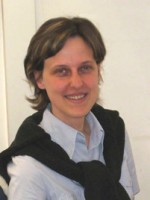2010 SwissTB Award
Dr. Claudia Sala
 The genome sequence of Mycobacterium tuberculosis (Mtb) revealed the presence of more than a hundred proteins contributing to transcriptional regulation, thus indicating the complexity of the regulatory networks in this pathogen.
The genome sequence of Mycobacterium tuberculosis (Mtb) revealed the presence of more than a hundred proteins contributing to transcriptional regulation, thus indicating the complexity of the regulatory networks in this pathogen.
In the context of the European 6th Framework Program « New Medicines for Tuberculosis » (NM4TB), I developed the ChIP-on-chip technique, also known as « Chromatin Immunoprecipitation and Hybridization to Microarrays », with the aim of constructing a regulatory map of the Mtb genome. The principle behind this approach is as follows : cross-linked nucleo-protein complexes are used in immunoprecipitation experiments that result in enrichment of the DNA sequences bound by the protein of interest. The putative binding sites are then mapped to the genome and integrated with data coming from different approaches, such as transcriptomics, in order to obtain a global view of Mtb gene expression
ChIP-on-chip was successfully applied to study BlaI (Rv1846c), predicted to be involved in resistance to beta-lactams. Our results revealed that BlaI directly controls a small subset of genes, including its own, the gene encoding the beta-lactamase, and the ATP synthase operon. These findings unveiled unexpected links between beta-lactam-induced cell wall damage and ATP production
Also in NM4TB, I contributed to the development and testing of the promising new TB drug candidate, benzothiazinone (BTZ), on a model of non-replicating Mtb. Our data indicate that the BTZ is highly effective against actively growing Mtb and displays poor activity against non-growing cells. This is consistent with the identified target, a step in active cell wall metabolism represented by arabinan synthesis.
Publication
Genome-wide regulon and crystal structure of BlaI (Rv1846c) from Mycobacterium tuberculosis.
Claudia Sala1, Ahmed Haouz2, Frederick A. Saul2, Isabelle Miras2, Ida Rosenkrands3, Pedro M. Alzari2 and Stewart T. Cole1
1Global Health Institute, Ecole Polytechnique Fédérale de Lausanne, CH-1015 Lausanne, Switzerland, 2Institut Pasteur, Département de Biologie Structurale et Chimie (URA 2185 CNRS), 75724 Paris, France, 3Department of Infectious Disease Immunology, Statens Serum Institut, Artillerivej 5, DK-2300 Copenhagen S,
Denmark
